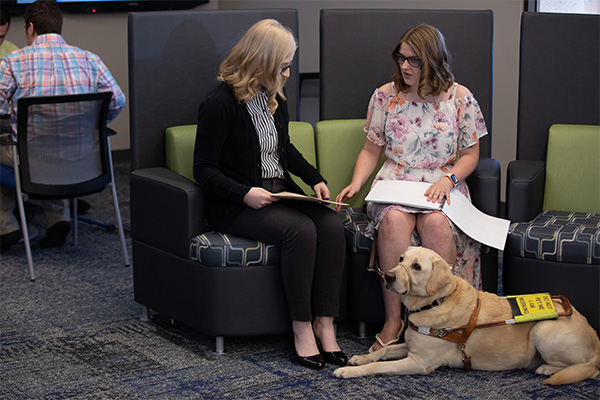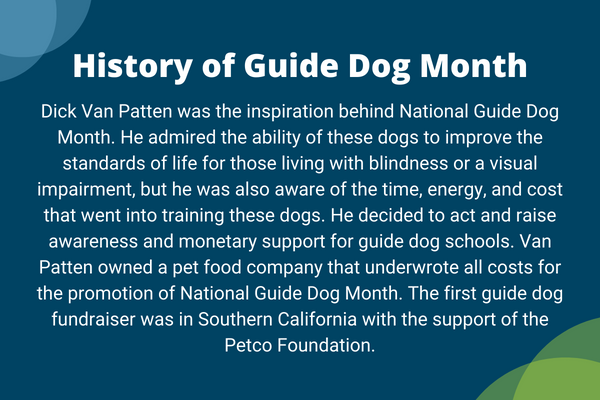National Guide Dog Month: Etiquette, Facts and More
By Holly Herring • Sep 08, 2022

Blog Content
Not only is a dog man’s best friend, but a dog can also be a vital safety and mobility resource for people who are blind or visually impaired. September is National Guide Dog Month and an important time to raise awareness about and appreciate the hard work of guide dogs and their owners.
At Envision, several employees who are blind or visually impaired have guide dogs at home and at work, therefore we greatly understand the benefits of the connection between guide dog and owner.
When navigating with a guide dog, a person who is blind or visually impaired relies on the dog to avoid obstacles, stop for curbs and crossings, find objects such as doors, exits, and stairs, and generally helps the person arrive safely to their destination. Being able to navigate independently through various public spaces is an invaluable feeling for people who are blind or visually impaired. Plus, a dog provides companionship which is said to help
reduce feelings of loneliness.
A working dog is always alert and busy concentrating on commands and its surrounding. They are highly trained to know the difference between when their harness is on (work time!) and when the harness is off (play time!). Distracting a working dog can be frustrating to the handler and may put both dog and human in danger.
Follow These Tips For Proper Etiquette When Encountering A Guide Dog
- Don’t interact with a working dog by petting, calling out the dog’s name, or giving the dog commands. A guide dog should only hear commands from its handler.
- Don’t allow children to interact with the dog. Do teach children the difference between a pet and a service dog.
- Don’t allow your pets to interact with a working guide dog.
- Don’t feed the dog anything without the handler’s permission, especially not table scraps. Guide dogs must maintain an ideal weight and fitness level, not to mention food being a natural distraction from work.
- Don’t attempt to guide, steer, or hold a person navigating with a guide dog. Do let the dog work.
- If the dog is out of harness, do ask permission to pet the dog or to allow children to pet the dog. If the dog is resting, do allow it to rest without disturbing it.
- Do walk on the handler’s right side, a few paces behind. Right-handed handlers often work their dogs on their left side while walking. Walking on the left side (the dog side) may distract the dog.
- Guide dogs learn to be responsible for a space two times as wide and up to three times as tall as themselves to keep their owners safe.
- The most popular guide dog breeds are Labradors, Golden Retrievers and German Shepherds, who are chosen for their size, temperament, and intelligence.
- The training for dogs to become guide dogs takes about 2-3 months and then guide dog and owner train together for several weeks.
- Guide dogs usually retire between ages 8 to 10 years old.
- Guide dogs are allowed in any public space including restaurants, stores, office buildings, and even rideshares like Lyft and Uber. Click here to read more about where guide dogs are allowed.
.png)